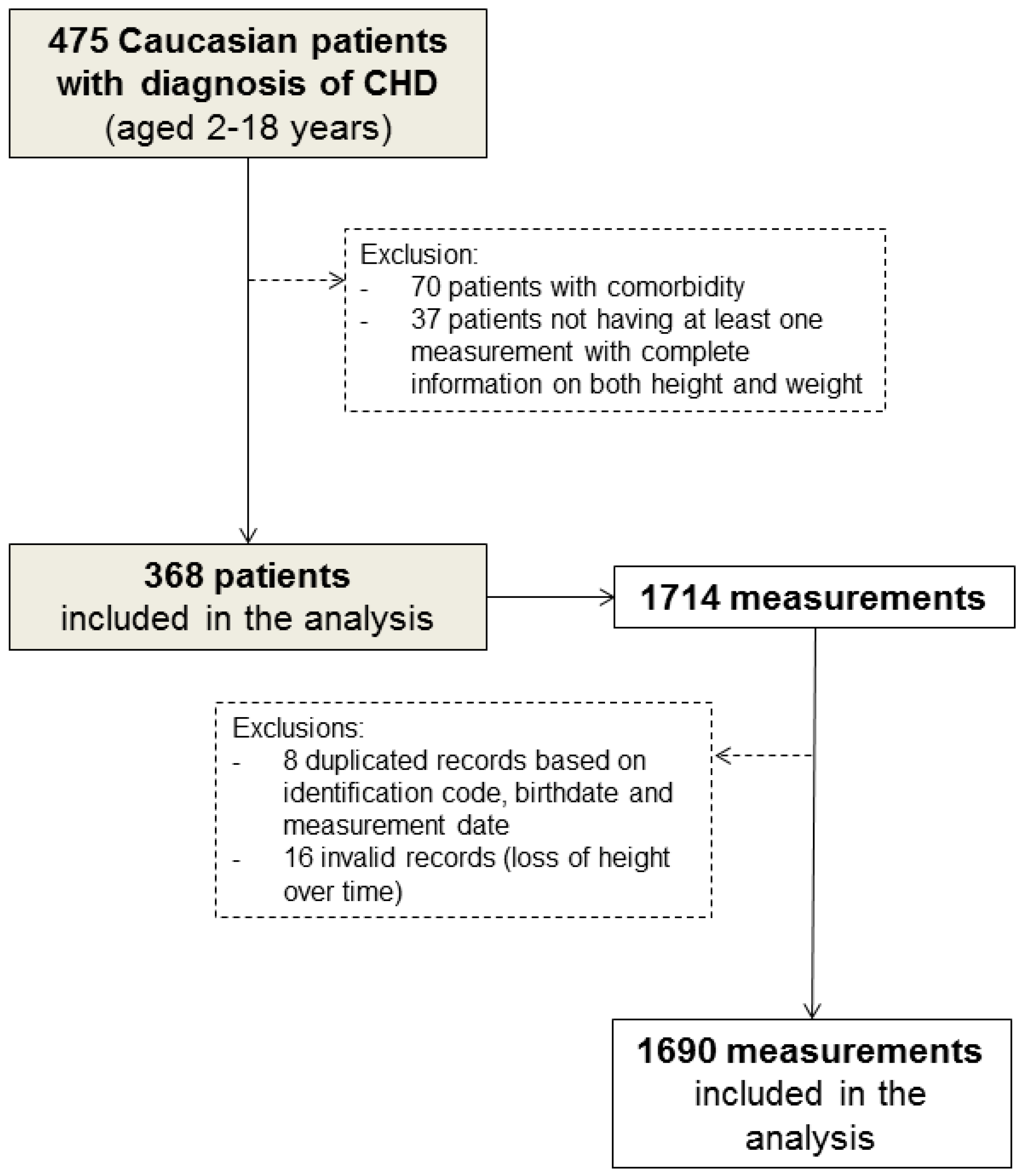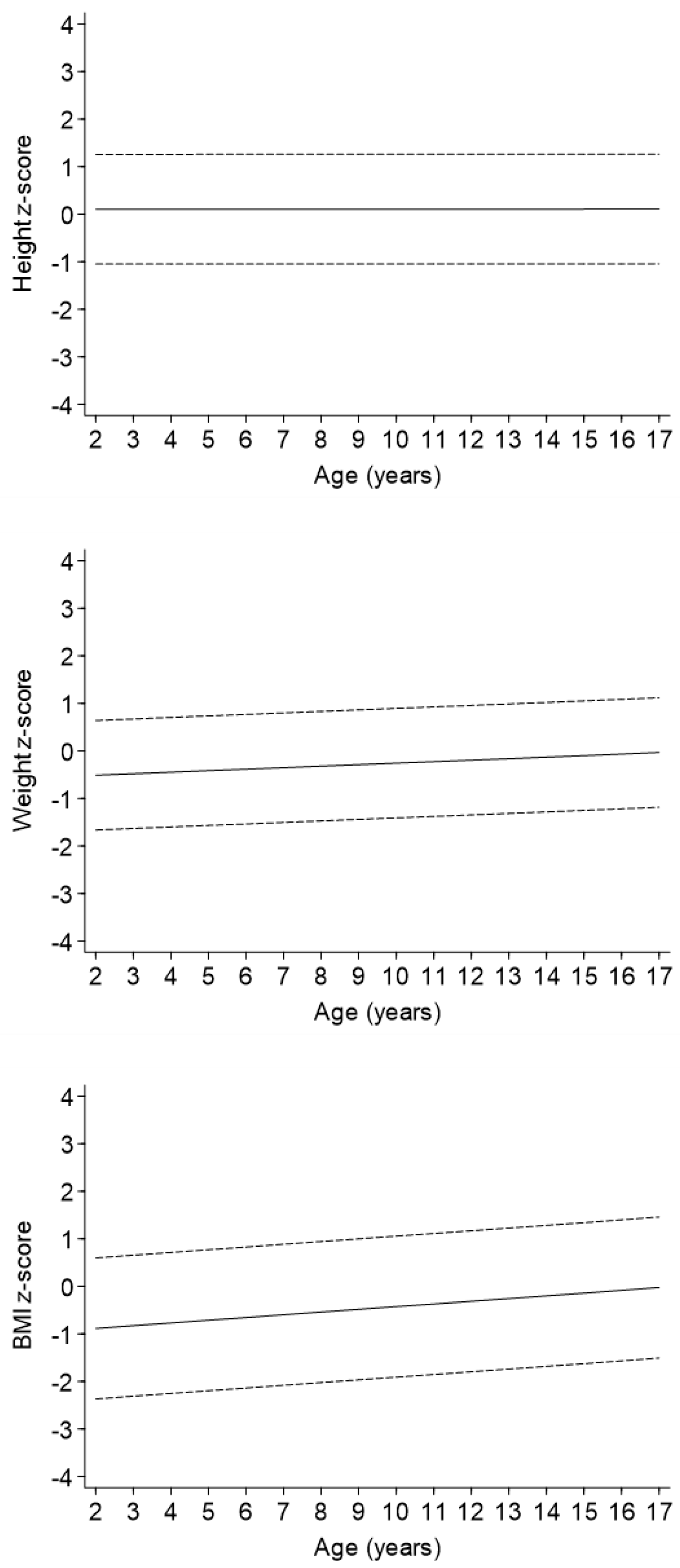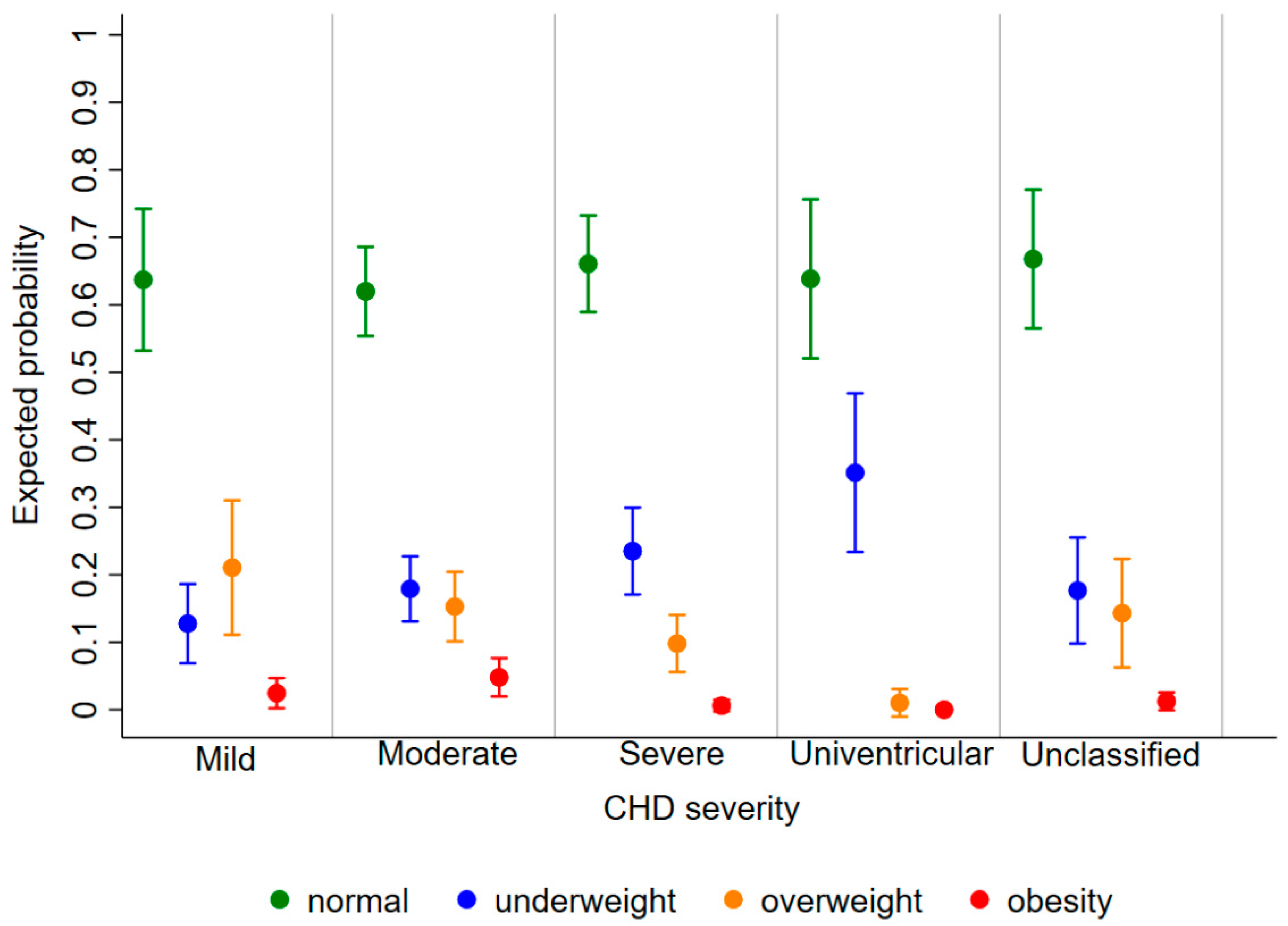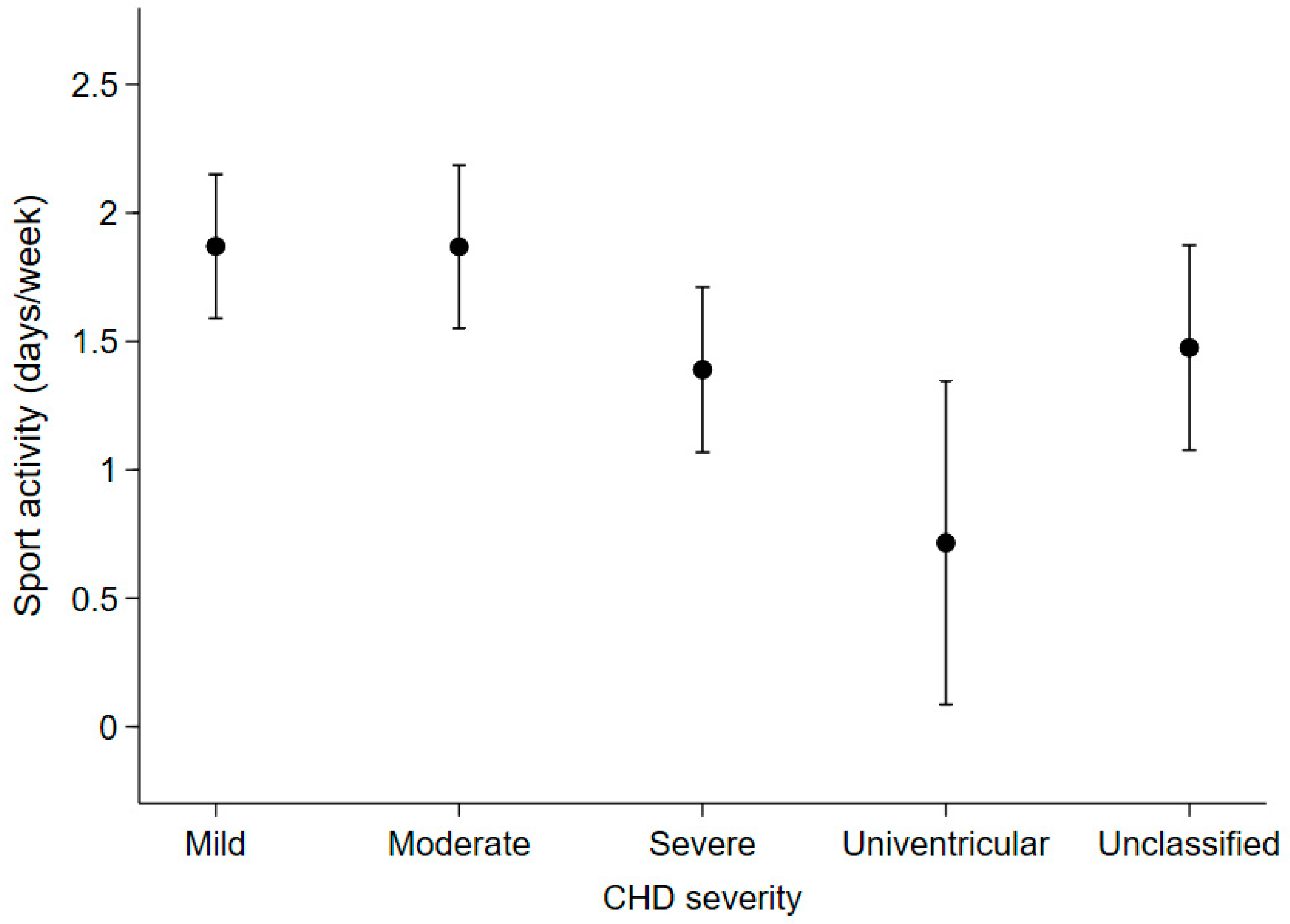Congenital Heart Disease: Growth Evaluation and Sport Activity in a Paediatric Population
Abstract
:1. Introduction
2. Materials and Methods
2.1. Study Design
2.2. Study Participants
2.3. Definitions
2.4. Statistical Analysis
3. Results
3.1. Patient Characteristics
3.2. Anthropometric Indices
3.3. Weight Status
3.4. Sport Activity
4. Discussion
4.1. Anthropometric Indices
4.2. Weight Status
4.3. Sport Activity
5. Study Limitations
6. Conclusions
Supplementary Materials
Author Contributions
Funding
Institutional Review Board Statement
Informed Consent Statement
Data Availability Statement
Conflicts of Interest
References
- Ishikawa, T.; Iwashima, S.; Ohishi, A.; Nakagawa, Y.; Ohzeki, T. Prevalence of congenital heart disease assessed by echocardiography in 2067 consecutive newborns. Acta Paediatr. 2011, 100, e55–e60. [Google Scholar] [CrossRef] [PubMed]
- Khoshnood, B.; Lelong, N.; Houyel, L.; Thieulin, A.C.; Jouannic, J.M.; Magnier, S.; Delezoide, A.L.; Magny, J.F.; Rambaud, C.; Bonnet, D.; et al. Prevalence, timing of diagnosis and mortality of newborns with congenital heart defects: A population-based study. Heart 2012, 98, 1667–1673. [Google Scholar] [CrossRef] [PubMed]
- Webb, G.; Mulder, B.J.; Aboulhosn, J.; Daniels, C.J.; Elizari, M.A.; Hong, G.; Horlick, E.; Landzberg, M.J.; Marelli, A.J.; O’Donnell, C.P.; et al. The care of adults with congenital heart disease across the globe: Current assessment and future perspective: A position statement from the International Society for Adult Congenital Heart Disease (ISACHD). Int. J. Cardiol. 2015, 195, 326–333. [Google Scholar] [CrossRef] [PubMed]
- Daymont, C.; Neal, A.; Prosnitz, A.; Cohen, M.S. Growth in children with congenital heart disease. Pediatrics 2013, 131, e236–e242. [Google Scholar] [CrossRef] [PubMed] [Green Version]
- Tutarel, O. Acquired heart conditions in adults with congenital heart disease: A growing problem. Heart 2014, 100, 1317–1321. [Google Scholar] [CrossRef] [PubMed]
- Engelings, C.C.; Helm, P.C.; Abdul-Khaliq, H.; Asfour, B.; Bauer, U.M.; Baumgartner, H.; Kececioglu, D.; Körten, M.A.; Diller, G.P.; Tutarel, O. Cause of death in adults with congenital heart disease—An analysis of the German National Register for Congenital Heart Defects. Int. J. Cardiol. 2016, 211, 31–36. [Google Scholar] [CrossRef] [PubMed]
- Tutarel, O.; Kempny, A.; Alonso-Gonzalez, R.; Jabbour, R.; Li, W.; Uebing, A.; Dimopoulos, K.; Swan, L.; Gatzoulis, M.A.; Diller, G.P. Congenital heart disease beyond the age of 60: Emergence of a new population with high resource utilization, high morbidity, and high mortality. Eur. Heart J. 2014, 35, 725–732. [Google Scholar] [CrossRef] [Green Version]
- Ogden, C.L.; Carroll, M.D.; Lawman, H.G.; Fryar, C.D.; Kruszon-Moran, D.; Kit, B.K.; Flegal, K.M. Trends in Obesity Prevalence Among Children and Adolescents in the United States, 1988–1994 Through 2013–2014. JAMA 2016, 315, 2292–2299. [Google Scholar] [CrossRef]
- Willinger, L.; Brudy, L.; Meyer, M.; Oberhoffer-Fritz, R.; Ewert, P.; Müller, J. Overweight and Obesity in Patients with Congenital Heart Disease: A Systematic Review. Int. J. Environ. Res Public Health 2021, 18, 9931. [Google Scholar] [CrossRef]
- Schwartz, S.; Olsen, M.; Woo, J.G.; Madsen, N. Congenital heart disease and the prevalence of underweight and obesity from age 1 to 15 years: On a nationwide sample of children. BMJ Paediatr. Open 2017, 1, e000127. [Google Scholar] [CrossRef] [Green Version]
- Lui, G.K.; Fernandes, S.; McElhinney, D.B. Management of Cardiovascular Risk Factors in Adults with Congenital Heart Disease. J. Am. Heart Assoc. 2014, 3, e001076. [Google Scholar] [CrossRef] [PubMed] [Green Version]
- Cacciari, E.; Milani, S.; Balsamo, A.; Spada, E.; Bona, G.; Cavallo, L.; Cerutti, F.; Gargantini, L.; Greggio, N.; Tonini, G.; et al. Italian cross-sectional growth charts for height, weight and BMI (2 to 20 yr). J. Endocrinol. Investig. 2006, 29, 581–593. [Google Scholar] [CrossRef] [PubMed]
- Erikssen, G.; Liestøl, K.; Seem, E.; Birkeland, S.; Saatvedt, K.J.; Hoel, T.N.; Døhlen, G.; Skulstad, H.; Svennevig, J.L.; Thaulow, E.; et al. Achievements in Congenital Heart Defect Surgery Clinical Perspective: A Prospective, 40-Year Study of 7038 Patients. Circulation 2015, 131, 337–346. [Google Scholar] [CrossRef] [PubMed] [Green Version]
- Goldstein, H. Multilevel Statistical Models; John Wiley & Sons: Hoboken, NJ, USA, 2011; 376p. [Google Scholar]
- Tamayo, C.; Manlhiot, C.; Patterson, K.; Lalani, S.; McCrindle, B.W. Longitudinal Evaluation of the Prevalence of Overweight/Obesity in Children with Congenital Heart Disease. Can. J. Cardiol. 2015, 31, 117–123. [Google Scholar] [CrossRef]
- Costello, C.L.; Gellatly, M.; Daniel, J.; Justo, R.N.; Weir, K. Growth Restriction in Infants and Young Children with Congenital Heart Disease: Growth Restriction in Congenital Heart Disease. Congenit. Heart Dis. 2015, 10, 447–456. [Google Scholar] [CrossRef]
- Harris, K.C.; Voss, C.; Rankin, K.; Aminzadah, B.; Gardner, R.; Mackie, A.S. Modifiable cardiovascular risk factors in adolescents and adults with congenital heart disease. Congenit Heart Dis 2018, 13, 563–570. [Google Scholar] [CrossRef]
- Deen, J.F.; Krieger, E.V.; Slee, A.E.; Arslan, A.; Arterburn, D.; Stout, K.K.; Portman, M.A. Metabolic syndrome in adults with congenital heart disease. J. Am. Heart Assoc. 2016, 5, e001132. [Google Scholar] [CrossRef] [Green Version]
- Chen, C.-A.; Wang, J.-K.; Lue, H.-C.; Hua, Y.-C.; Chang, M.-H.; Wu, M.-H. A Shift from Underweight to Overweight and Obesity in Asian Children and Adolescents with Congenital Heart Disease: Body mass index in congenital heart disease. Paediatr. Perinat. Epidemiol. 2012, 26, 336–343. [Google Scholar] [CrossRef]
- Pinto, N.M.; Marino, B.S.; Wernovsky, G.; De Ferranti, S.D.; Walsh, A.Z.; Laronde, M.; Hyland, K.; Dunn, S.O.; Cohen, M.S. Obesity is a common comorbidity in children with congenital and acquired heart disease. Pediatrics 2007, 120, e1157–e1164. [Google Scholar] [CrossRef]
- Lauria, L.; Spinelli, A.; Buoncristiano, M.; Nardone, P. Decline of Childhood Overweight and Obesity in Italy from 2008 to 2016. BMC Public Health 2019, 19, 618. [Google Scholar] [CrossRef]
- Güngör, N.K. Overweight and obesity in children and adolescents. J. Clin. Res. Pediatric Endocrinol. 2014, 6, 129–143. [Google Scholar] [CrossRef] [PubMed]
- Caterini, J.E.; Campisi, E.S.; Cifra, B. Physical Activity Promotion in Pediatric Congenital Heart Disease: Are We Running Late? Can. J. Cardiol. 2020, 36, 1406–1416. [Google Scholar] [CrossRef] [PubMed]
- Reybrouck, T.; Mertens, L. Physical performance and physical activity in grown-up congenital heart disease. Eur. J. Cardiovasc. Prev. Rehabil. 2005, 12, 498–502. [Google Scholar] [CrossRef] [PubMed]
- Takken, T.; Giardini, A.; Reybrouck, T.; Gewillig, M.; Hövels-Gürich, H.H.; Longmuir, P.E.; McCrindle, B.W.; Paridon, S.M.; Hager, A. Recommendations for physical activity, recreation sport, and exercise training in paediatric patients with congenital heart disease: A report from the Exercise, Basic & Translational Research Section of the European Association of Cardiovascular Prevention and Rehabilitation, the European Congenital Heart and Lung Exercise Group, and the Association for European Paediatric Cardiology. Eur. J. Prev. Cardiol. 2012, 19, 1034–1065. [Google Scholar]
- Graham, T.P.; Driscoll, D.J.; Newburger, J.W. Task force 2: Congenital heart Disease. JACC 2005, 45, 1326–1333. [Google Scholar] [CrossRef] [Green Version]
- Bjarnason-Wehrens, B.; Dordel, S.; Schickendantz, S.; Krumm, C.; Bott, D.; Sreeram, N.; Brockmeier, K. Motor development in children with congenital cardiac diseases compared to their healthy peers. Cardiol. Young 2007, 17, 487–498. [Google Scholar] [CrossRef]
- Dean, P.N.; Gillespie, C.W.; Greene, E.A.; Pearson, G.D.; Robb, A.S.; Berul, C.I.; Kaltman, J.R. Sports participation and quality of life in adolescents and young adults with congenital heart disease. Congenit. Heart Dis. 2015, 10, 169–179. [Google Scholar] [CrossRef]
- Liu, M.; Wu, L.; Ming, Q. How Does Physical Activity Intervention Improve Self-Esteem and Self-Concept in Children and Adolescents? Evidence from a Meta-Analysis. PLoS ONE 2015, 10, e0134804. [Google Scholar] [CrossRef]
- Stefan, M.A.; Hopman, W.M.; Smythe, J.F. Effect of activity restriction owing to heart disease on obesity. Arch. Pediatrics Adolesc. Med. 2005, 159, 477–481. [Google Scholar] [CrossRef] [Green Version]
- Longmuir, P.E.; Brothers, J.A.; De Ferranti, S.D.; Hayman, L.L.; Van Hare, G.F.; Matherne, G.P.; Davis, C.K.; Joy, E.A.; McCrindle, B.W. Promotion of Physical Activity for Children and Adults with Congenital Heart Disease: A Scientific Statement from the American Heart Association. Circulation 2013, 127, 2147–2159. [Google Scholar] [CrossRef] [Green Version]
- Delise, P.; Mos, L.; Sciarra, L.; Basso, C.; Biffi, A.; Cecchi, F.; Furio, C.; Domenico, C.; Antonello, D.; Ernesto, D.C.; et al. Italian Cardiological Guidelines (COCIS) for Competitive Sport Eligibility in athletes with heart disease: Update 2020. J. Cardiovasc. Med. 2021, 22, 874–891. [Google Scholar] [CrossRef] [PubMed]
- Longmuir, P.E.; McCrindle, B.W. Physical activity restrictions for children after the Fontan operation: Disagreement between parent, cardiologist, and medical record reports. Am. Heart J. 2009, 157, 853–859. [Google Scholar] [CrossRef] [PubMed]
- Williams, C.A.; Wadey, C.; Pieles, G.; Stuart, G.; Taylor, R.S.; Long, L. Physical activity interventions for people with congenital heart disease. In Cochrane Database of Systematic Reviews; John Wiley & Sons: Hoboken, NJ, USA, 2020. [Google Scholar]





| N = 368 | |
|---|---|
| Sex (female), % | 40.8 |
| Age at first recording (years), median (range) | 5 (2–14) |
| Age at last measurement (years), median (range) | 10 (2–18) |
| Duration of follow-up (years), median (range) | 5.2 (0.0–12.7) |
| Number of measurements per patient, median (range) | 7 (1–21) |
| Patients with only one recording of height and weight, % | 24.7 |
| CHD severity, % | |
| Mild | 38.9 |
| Moderate | 26.3 |
| Severe | 18.5 |
| Univentricular | 3.3 |
| Not classified | 13.0 |
| Number of surgical interventions, median (range) | 0 (0–4) |
| Height at first recording (centimeters), mean ± sd | 110.5 ± 18.8 |
| Height z-score at first recording, mean ± sd | 0.1 ± 1.2 |
| Weight at first recording (kilograms), mean ± sd | 20.2 ± 9.6 |
| Weight z-score at first recording, mean ± sd | −0.5 ± 1.2 |
| Body mass index at first recording, mean ± sd | 15.7 ± 2.5 |
| Body mass index z-score at first recording, mean ± sd | −0.8 ± 1.9 |
| BMI category at first recording, % | |
| Underweight | 24.7 |
| Normal weight | 58.2 |
| Overweight | 15.2 |
| Obese | 1.9 |
| Age at end of the study (years) *, median (range) | 12 (7–18) |
| CHD severity *, % | |
| Mild | 34.6 |
| Moderate | 28.2 |
| Severe | 20.3 |
| Univentricular | 2.6 |
| Not classified | 14.3 |
| Number of days spent per week in sports activities *, mean ± sd | 1.7 ± 1.3 |
| Height z-Score | Weight z-Score | BMI z-Score | ||
|---|---|---|---|---|
| Variables of Interest | Beta (95%CI) | Beta (95%CI) | Beta (95%CI) | |
| Model 1 * | Age (years) | 0.00 (−0.01, 0.01) | 0.03 (0.02, 0.05) | 0.06 (0.03, 0.08) |
| Model 2 * | Age (years) | 0.00 (−0.01, 0.02) | 0.03 (0.01, 0.04) | 0.05 (0.02, 0.08) |
| Severity (vs. mild) | ||||
| moderate | −0.13 (−0.49, 0.23) | −0.52 (−0.86, −0.17) | −0.88 (−1.41, −0.36) | |
| severe | −0.19 (−0.58, 0.20) | −0.70 (−1.08, −0.32) | −1.12 (−1.67, −0.57) | |
| univentricular | −1.13 (−1.81, −0.45) | −1.85 (−2.5, −1.16) | −1.73 (−2.60, −0.86) | |
| not classified | −0.07 (−0.41, 0.27) | −0.04 (−0.39, 0.32) | −0.12 (−0.51, 0.28) |
| S1 Patients N = 91 | S2 Patients N = 277 | p Value | Statistical Test | |
|---|---|---|---|---|
| Sex (female), % | 44.0 | 39.7 | 0.539 | Fisher’s exact test |
| Age at first recording (years), median | 3 | 6 | <0.001 | Mood’s Median test |
| CHD severity, % | ||||
| Mild | 71.4 | 28.2 | <0.001 | Fisher’s exact test |
| Moderate | 14.3 | 30.3 | ||
| Severe | 4.4 | 23.1 | ||
| Univentricular | 3.3 | 3.2 | ||
| Not classified | 6.6 | 15.2 | ||
| BMI category at first Recording, % | ||||
| Underweight | 18.7 | 26.7 | 0.269 | Fisher’s exact test |
| Normal weight | 67.0 | 55.2 | ||
| Overweight | 13.2 | 15.9 | ||
| Obese | 1.1 | 2.2 | ||
| Number of days spent per week in sports activities *, mean | 1.8 | 1.7 | 0.468 | Student’s t-Test |
Publisher’s Note: MDPI stays neutral with regard to jurisdictional claims in published maps and institutional affiliations. |
© 2022 by the authors. Licensee MDPI, Basel, Switzerland. This article is an open access article distributed under the terms and conditions of the Creative Commons Attribution (CC BY) license (https://creativecommons.org/licenses/by/4.0/).
Share and Cite
Zoller, T.; Prioli, M.A.; Clemente, M.; Pilati, M.; Sandrini, C.; Luciani, G.B.; Deganello Saccomani, M.; Ficial, B.; Gaffuri, M.; Piacentini, G.; et al. Congenital Heart Disease: Growth Evaluation and Sport Activity in a Paediatric Population. Children 2022, 9, 884. https://doi.org/10.3390/children9060884
Zoller T, Prioli MA, Clemente M, Pilati M, Sandrini C, Luciani GB, Deganello Saccomani M, Ficial B, Gaffuri M, Piacentini G, et al. Congenital Heart Disease: Growth Evaluation and Sport Activity in a Paediatric Population. Children. 2022; 9(6):884. https://doi.org/10.3390/children9060884
Chicago/Turabian StyleZoller, Thomas, Maria Antonia Prioli, Maria Clemente, Mara Pilati, Camilla Sandrini, Giovanni Battista Luciani, Marco Deganello Saccomani, Benjamim Ficial, Marcella Gaffuri, Giorgio Piacentini, and et al. 2022. "Congenital Heart Disease: Growth Evaluation and Sport Activity in a Paediatric Population" Children 9, no. 6: 884. https://doi.org/10.3390/children9060884
APA StyleZoller, T., Prioli, M. A., Clemente, M., Pilati, M., Sandrini, C., Luciani, G. B., Deganello Saccomani, M., Ficial, B., Gaffuri, M., Piacentini, G., Calciano, L., & Pietrobelli, A. (2022). Congenital Heart Disease: Growth Evaluation and Sport Activity in a Paediatric Population. Children, 9(6), 884. https://doi.org/10.3390/children9060884







